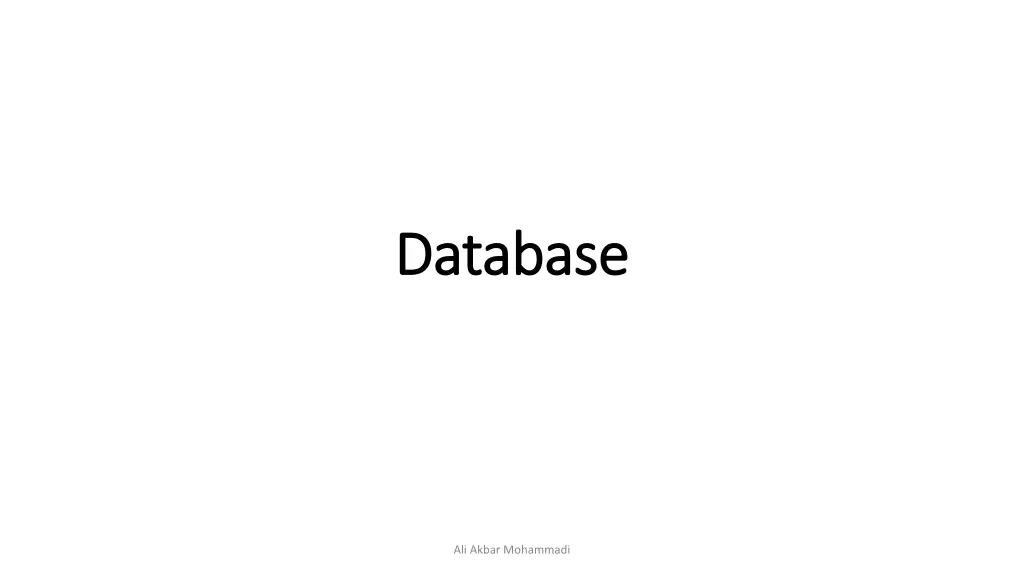
Understanding Database Management Systems and Their Importance
Explore the fundamentals of database management systems (DBMS), their role in maintaining organized data, and the benefits they offer for efficient data management. Learn about the significance of DBMS in managing information effectively and improving business operations.
Download Presentation

Please find below an Image/Link to download the presentation.
The content on the website is provided AS IS for your information and personal use only. It may not be sold, licensed, or shared on other websites without obtaining consent from the author. If you encounter any issues during the download, it is possible that the publisher has removed the file from their server.
You are allowed to download the files provided on this website for personal or commercial use, subject to the condition that they are used lawfully. All files are the property of their respective owners.
The content on the website is provided AS IS for your information and personal use only. It may not be sold, licensed, or shared on other websites without obtaining consent from the author.
E N D
Presentation Transcript
Database Database Ali Akbar Mohammadi
What What is a Database is a Database? ? A collection of related pieces of data: Representing/capturing the information about a real-world enterprise or part of an enterprise. Collected and maintained to serve specific data management needs of the enterprise. Activities of the enterprise are supported by the database and continually update the database. Ali Akbar Mohammadi 2
Example: University Database Example: University Database Data about students, faculty, courses, research-laboratories, course registration/enrollment etc. Reflects the state of affairs of the academic aspects of the university. Purpose: To keep an accurate track of the academic activities of the university. Ali Akbar Mohammadi 3
Database Database Management System (DBMS Management System (DBMS) ) A general purpose software system enabling: Creation of large disk-resident databases. Posing of data retrieval queries in a standard manner. Retrieval of query results efficiently. Concurrent use of the system by a large number of users in a consistent manner. Guaranteed availability of data irrespective of system failures Ali Akbar Mohammadi 4
OS OS File System Storage Based File System Storage Based Approach Approach Files of records used for data storage Data redundancy wastage of space Maintaining consistency becomes difficult Record structures hard coded into the programs Structure modifications hard to perform Each different data access request (a query) Performed by a separate program Difficult to anticipate all such requests Creating the system Requires a lot of effort Managing concurrent access and failure recovery are difficult Ali Akbar Mohammadi 5
DBMS Approach DBMS Approach DBMS Separation of data and metadata Flexibility of changing metadata Program-data independence Data access language Standardized SQL (Structured Query Language) Ad-hoc query formulation easy System development Less effort required Concentration on logical level design is enough Components to organize data storage, process queries, manage concurrent access, recovery from failures, manage access control are all available Ali Akbar Mohammadi 6
Data Model Data Model Collection of conceptual tools to describe the database at a certain level of abstraction. Conceptual Data Model A high level description Useful for requirements understanding. Representational Data Model Describing the logical representation of data without giving details of physical representation. Physical Data Model Description giving details about record formats, file structures etc. Ali Akbar Mohammadi 7
E/R (Entity/Relationship E/R (Entity/Relationship) ) Model Model A conceptual level data model. Provides the concepts of entities, relationships and attributes. -The University Database Context Entities: student, faculty member, course, departments etc. Relationships: enrollment relationship between student & course, employment relationship between faculty member, department etc. Attributes: name, rollNumber, address etc., of student entity, name, empNumber, phoneNumberetc., of faculty entity etc. Ali Akbar Mohammadi 8
Representational Level Data Model Representational Level Data Model Relational Model :Provides the concept of a relation. In the context of university database: Attributes Relation name Student SName RollNumber JoiningYear BirthDate Program Dept Ali CS04B123 2008 15Aug1982 BTech CS . . . . . . . . . . . . . . . . . . Data Tuple Relation scheme: Attribute names of the relation. Relation data/instance: set of data tuples. Ali Akbar Mohammadi 9
